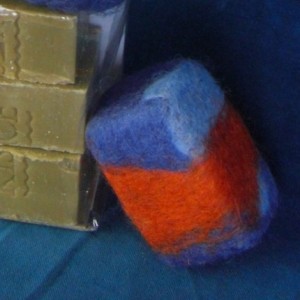Leah Adams of SpiderFelt is generously offering one of my readers a chance to win her lovely Verbena Felt Soap Kit, so fragrant and pretty. Leah is a talented felt designer who evolves daily in creating exquisite felted items to wear, hold, as well as kits for those who want to make their own felt items. She is an artist who has taken her felting art into brilliant realms. Her knowledge of felt is amazing and we are so lucky to be a part of her world. We would like you to become a fan of Leah’s SpiderFelt on Facebook. If you do not have an account, please think about signing up and joining us on Facebook. The giveaway will run for 10 days, from October 23, 2009 through November 1, 2009. To enter, simply go to Leah’s SpiderFelt Shop and select an item you like, then come back here and post about the item you love in the comment section here. This giveaway will end at midnight EST November 1st. Good luck to everyone.
Have you read?
25 Crochet Patterns For Frogs
Hello, fellow crochet enthusiasts! Today, we’re diving into the enchanting world of frogs with a special roundup dedicated to all things green a slimey, frogs. This article is actually giving me a let PTSD from when I sat on a toilet at 5 years old and a green frog jumped up out of the bowl and onto my bottom. The frog suctioned itself onto me. I still, look down first, before I go to the toilet, 40 years later. So yeah, I am not a very big fan of frogs.
Whether you’re a seasoned crochet artist or a beginner looking for a fun new project, this collection of frog-inspired patterns is sure to jumpstart your creativity, some are a little more intricate than others, but take a look and choose one to suit your skill level.
From adorable amigurumi frogs to practical and whimsical home decor, our curated selection features a wide variety of frog patterns that cater to every taste and skill level. Let’s hop right in and explore these delightful patterns!
Amigurumi Frogs These cute and cuddly frogs are perfect for those who love making amigurumi. They make great gifts or charming additions to your collection.
Frog Wall Hanging Crochet Pattern – Free Pattern – Stitch by Fay
Frog Coaster Crochet Pattern (Free!) Protect your surfaces with these adorable frog coasters that are both functional and fun.
Frog Baby Bib Keep mealtime mess-free with this adorable frog baby bib that combines practicality with cuteness
Frog Beanie Keep warm and stylish with this cozy frog beanie, perfect for frog lovers of all ages
Matchbox Frog This tiny matchbox frog is perfect for a quick and charming project that fits right in your pocket.
Ravelry: Frog keychain pattern by Ami Little Creature
Frog bookmark Make reading time fun with this charming frog bookmark.
Ravelry: Frog Backpack pattern by Lily / Sugar’n Cream
Ravelry: frog prince pattern by Amigurumi Today
Ravelry: Frog Hanging Basket pattern by StringyDingDing
Ravelry: Frog Coasters pattern by Dawn M Castillo
Ravelry: Fancy Frog pattern by Tiny Curl
Ravelry: Tree Frog pattern by Brigitte Read Capture the beauty of tree frogs with this detailed and vibrant pattern.


